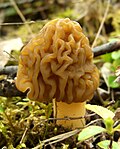Paraphyses are erect sterile filament-like support structures occurring among the reproductive apparatuses of fungi, ferns, bryophytes and some thallophytes...
1 KB (148 words) - 11:10, 6 February 2024
cells develop into sterile cells called cystidia (basidiomycetes) or paraphyses (ascomycetes). Cystidia are often important for microscopic identification...
3 KB (295 words) - 22:15, 18 September 2023
stinkhorns. Interspersed among the asci are threadlike sterile cells called paraphyses. Similar structures called cystidia often occur within the hymenium of...
47 KB (4,978 words) - 12:23, 21 May 2024
bodies barely exceeding 1–2 cm and has polymorphic, often moniliform paraphyses and predominantly 3-septate spores. Geoglossum dunense was described as...
6 KB (610 words) - 00:27, 23 May 2024
space, with both ends attached to the gills, help together by clasping paraphyses. As the gill expands the cystidium breaks away from one gill and projects...
12 KB (1,275 words) - 23:07, 3 May 2024
the shape of the spores (those of T. cupularis being narrower) and the paraphyses (those of T. cupularis lacking the distinctive lobed tips of T. catinus)...
2 KB (175 words) - 04:32, 10 January 2024
appearance and resembles a membrane, it is sessile, it does not have paraphyses, its asci are oblong, and its sporidia are biseriate and have an oblong-elliptical...
28 KB (2,267 words) - 07:29, 27 April 2024
are eight-spored, 223–300 by 19–20 μm, cylindrical, and hyaline. The paraphyses are filamentous, cylindrical, 5.8–8.8 μm wide, and hyaline. The hyphae...
25 KB (2,713 words) - 17:50, 16 May 2024
often contain two small oil droplets, and measure 11–15 by 6–10 μm. The paraphyses are slender, contain septa, and are slightly enlarged above. The species...
10 KB (822 words) - 03:56, 10 March 2024
including functionless stipules and carpels, leaf reduction of Equisetum, paraphyses of Fungi. Well known examples are the reductions in floral display, leading...
32 KB (3,876 words) - 05:01, 7 May 2024
distinctive feature of Teloschistaceae is the presence of the gelatinous paraphyses (filament-like support structures in the reproductive apparatus), with...
140 KB (12,107 words) - 05:01, 13 April 2024
both antheridia and archegonia, either together or on separate branches. Paraphyses – sterile hairs surrounding the archegonia and antheridia. Perianth –...
82 KB (10,353 words) - 06:29, 12 May 2024
conglutinated. Stuck or glued together; usually applied to hyphae or paraphyses. consoredium An aggregation or cluster of incompletely separated soredia...
219 KB (19,492 words) - 06:16, 12 May 2024
color and septation of the ascospores, and shape and ornamentation of the paraphyses. Geoglossum was described by Christian Hendrik Persoon in 1794, who created...
19 KB (1,541 words) - 08:31, 26 May 2024
differences in microscopic characteristics, such as spores, asci, and paraphyses. First described in 1796 as a species of Geoglossum, the fungus has gone...
21 KB (1,907 words) - 04:24, 12 May 2024
by the shape of the spores (those of T. catinus being broader) and the paraphyses (those of T. catinus having distinctive lobed tips). The species is inedible...
2 KB (190 words) - 05:10, 10 January 2024
portion of hymenium showing the longitudinally interwoven hyphal ends or paraphyses and some probasidia; b, three spore-bearing organs; s, spores. × 640"...
8 KB (875 words) - 00:05, 17 May 2024
Boudier believed that the large, curved ascospores and the rare and short paraphyses were sufficiently distinct to warrant a new genus to contain the single...
27 KB (2,589 words) - 19:04, 18 May 2024
dehiscence (fruit body opening) is caused by the pressure exerted by swollen paraphyses—sterile (i.e., nonreproductive) cells that are interspersed between the...
33 KB (3,468 words) - 08:17, 27 April 2024
over time. The disc varies in colour from orange to orange-brown. The paraphyses (sterile fungal filaments) are slender and range from straight to flexuose...
7 KB (657 words) - 22:04, 19 June 2023
ascospores and paraphyses. Paraphyses are sterile cells' often with swollen tips and are at high turgor pressure. Tips of the paraphyses are very tightly...
5 KB (354 words) - 20:07, 14 October 2023
variable in thickness, yellow to yellowish-brown, containing crystals. The paraphyses are usually 1.0–1.5 μm in diameter, with some branching at the top. The...
6 KB (733 words) - 23:15, 9 April 2024
colourless, and the subhymenium beneath it is pale brown, 20–35 μm thick. Paraphyses are 1.5–2.0 μm wide, sparsely branched, with dark brown capped tips. The...
4 KB (444 words) - 07:39, 19 May 2024
Caloplaca austrocitrina has a thickness of 60 to 80 μm. The tips of the paraphyses are widened, measuring between 3.0 and 6.0 μm. The ascospores of the species...
7 KB (804 words) - 03:54, 12 May 2024
gall-like or blister-like tissues of the hosts. The asci form a layer lacking paraphyses, and they lack croziers. The ascospores frequently bud into multiple yeast...
8 KB (446 words) - 08:26, 2 November 2023
spore-producing asci, is clear, with simple to moderately branched paraphyses. These paraphyses end in a brown cap and contain a distinctive aeruginose pigment...
6 KB (630 words) - 19:18, 24 January 2024
rod-shaped), with brown central cells and hyaline (translucent) polar cells. Paraphyses of Savoryella are inconspicuous at maturity. The apical pore or apparatus...
26 KB (2,445 words) - 02:41, 16 May 2024
plurivora, but can be distinguished by its conidial dimensions. Also, the paraphyses of the former are up to 95μm long and 4μm wide, whereas those of L. plurivora...
3 KB (302 words) - 03:35, 21 January 2024
hymenium has a height of 150–200 μm and is inspersed with apically branched paraphyses. The ascospores are 80–100 by 17–22 μm in size, oblong, colourless, and...
8 KB (499 words) - 08:26, 24 August 2023
endoxylic thallus, with star-shaped to lirelloid apothecia, capitate paraphyses with a distinct pigment zone at the top of the apical cell, and lacks...
9 KB (763 words) - 01:04, 13 May 2024





















